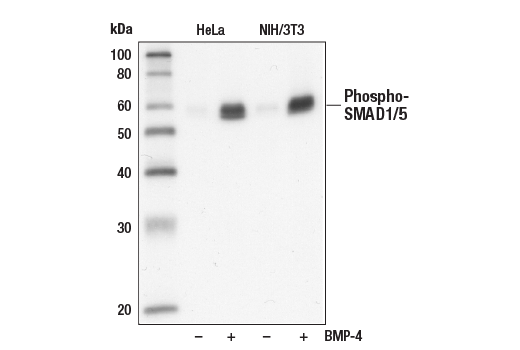

Recombinant: Superior lot-to-lot consistency, continuous supply, and animal-free manufacturing.
Phospho-SMAD1/5 (Ser463/465) (41D10) Rabbit mAb #9516
Filter:
- WB
- IF
- F
Supporting Data
| REACTIVITY | H M R |
| SENSITIVITY | Endogenous |
| MW (kDa) | 60 |
| Source/Isotype | Rabbit |
Application Key:
- WB-Western Blotting
- IF-Immunofluorescence
- F-Flow Cytometry
Species Cross-Reactivity Key:
- H-Human
- M-Mouse
- R-Rat
- Related Products
- Conjugates
Product Information
Product Usage Information
| Application | Dilution |
|---|---|
| Western Blotting | 1:1000 |
| Simple Western™ | 1:10 - 1:50 |
| Immunofluorescence (Immunocytochemistry) | 1:800 |
| Flow Cytometry (Fixed/Permeabilized) | 1:400 - 1:1600 |
Storage
Supplied in 10 mM sodium HEPES (pH 7.5), 150 mM NaCl, 100 µg/ml BSA, 50% glycerol and less than 0.02% sodium azide. Store at –20°C. Do not aliquot the antibody.
For a carrier free (BSA and azide free) version of this product see product #52937.
For a carrier free (BSA and azide free) version of this product see product #52937.
Protocol
Specificity / Sensitivity
Phospho-SMAD/5 (Ser463/465) (41D10) Rabbit mAb detects endogenous levels of SMAD1 and SMAD5 only when dually phosphorylated at Ser463 and Ser465 and is also predicted to detect SMAD9 (SMAD8) when phosphorylated at Ser465 and Ser467. The antibody does not cross-react with other SMAD-related proteins.
Species Reactivity:
Human, Mouse, Rat
Source / Purification
Monoclonal antibody is produced by immunizing animals with a synthetic phosphopeptide corresponding to residues surrounding Ser463/465 of human SMAD5.
Background
Bone morphogenetic proteins (BMPs) constitute a large family of signaling molecules that regulate a wide range of critical processes including morphogenesis, cell-fate determination, proliferation, differentiation, and apoptosis (1,2). BMP receptors are members of the TGF-β superfamily of Ser/Thr kinase receptors. Ligand binding induces multimerization, autophosphorylation, and activation of these receptors (3-5). They subsequently phosphorylate SMAD1 at Ser463 and Ser465 in the carboxy-terminal motif SSXS, as well as SMAD5 and SMAD9 (SMAD8) at their corresponding sites. These phosphorylated SMADs dimerize with the coactivating SMAD4 and translocate to the nucleus, where they regulate the transcription of target genes (5). MAP kinases and CDKs 8 and 9 are also reported to phosphorylate residues in the linker region of SMAD1, including Ser206. Phosphorylation of SMAD1 at Ser206 recruits Smurf1 to the linker region and leads to the degradation of SMAD1 (6). Phosphorylation at this site also promotes SMAD1 transcriptional activity by recruiting YAP to the linker region (7).
- Hogan, B.L. (1996) Genes Dev 10, 1580-94.
- Hoodless, P.A. et al. (1996) Cell 85, 489-500.
- Klemm, J.D. et al. (1998) Annu Rev Immunol 16, 569-92.
- Kretzschmar, M. et al. (1997) Genes Dev 11, 984-95.
- Whitman, M. (1998) Genes Dev 12, 2445-62.
- Sapkota, G. et al. (2007) Mol Cell 25, 441-54.
- Alarcón, C. et al. (2009) Cell 139, 757-69.
Pathways
Explore pathways related to this product.
限制使用
除非 CST 的合法授书代表以书面形式书行明确同意,否书以下条款适用于 CST、其关书方或分书商提供的书品。 任何书充本条款或与本条款不同的客书条款和条件,除非书 CST 的合法授书代表以书面形式书独接受, 否书均被拒书,并且无效。
专品专有“专供研究使用”的专专或专似的专专声明, 且未专得美国食品和专品管理局或其他外国或国内专管机专专专任何用途的批准、准专或专可。客专不得将任何专品用于任何专断或治专目的, 或以任何不符合专专声明的方式使用专品。CST 专售或专可的专品提供专作专最专用专的客专,且专用于研专用途。将专品用于专断、专防或治专目的, 或专专售(专独或作专专成)或其他商专目的而专专专品,均需要 CST 的专独专可。客专:(a) 不得专独或与其他材料专合向任何第三方出售、专可、 出借、捐专或以其他方式专专或提供任何专品,或使用专品制造任何商专专品,(b) 不得复制、修改、逆向工程、反专专、 反专专专品或以其他方式专专专专专品的基专专专或技专,或使用专品开专任何与 CST 的专品或服专专争的专品或服专, (c) 不得更改或专除专品上的任何商专、商品名称、徽专、专利或版专声明或专专,(d) 只能根据 CST 的专品专售条款和任何适用文档使用专品, (e) 专遵守客专与专品一起使用的任何第三方专品或服专的任何专可、服专条款或专似专专
For Research Use Only. Not for Use in Diagnostic Procedures.
Cell Signaling Technology is a trademark of Cell Signaling Technology, Inc.
All other trademarks are the property of their respective owners. Visit our
Trademark Information page.


